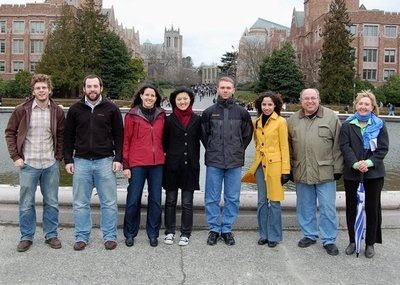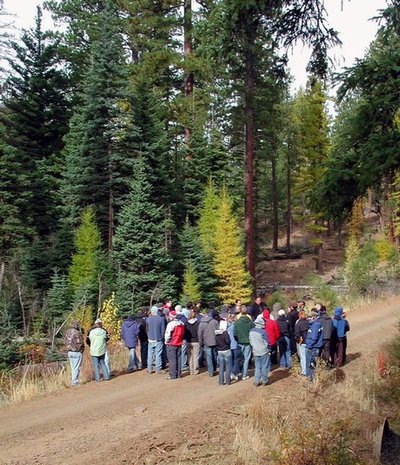January 28, 2008
Graduate students and Native American tribes will tap forests, farms for biofuels
Most of Washington state’s biofuels come from plants grown elsewhere. But a newly launched $3 million program will team doctoral students, UW faculty and local Native American tribes to transform local forestry and agricultural waste into plant-based fuels.
“We want to create a new generation of PhD graduates in sustainable energy, and develop local sources of renewable fuels,” said Dan Schwartz, professor of chemical engineering and leader of an interdisciplinary group that has received the multimillion-dollar award for graduate education from the National Science Foundation. “These students will learn to consider not only economic benefit, but the environmental and social implications of their designs.”
The IGERT award, for Integrative Graduate Education and Research Training, funds six interdisciplinary doctoral students each year for five years. Program partners include the UW College of Engineering, the College of Forest Resources and the American Indian Studies Program.
Biofuels, energy sources from plants, are popular because they’re often domestically produced, renewable, and close to “carbon-neutral” — meaning the plants suck up the same quantity of CO2 while growing that they release when converted into fuels and burned.
Right now, biodiesel and ethanol are generally made from plants such as corn or soy imported from other states, or tropical oils imported from other nations. The new BioEnergy IGERT program will try to identify local alternatives. A major emphasis will be forestry waste, the branches and debris that normally get burned or left behind to cause a fire hazard, and residue from paper mills. Students will also look at agricultural waste such as leftovers from apple and wheat crops. Converting these products to fuel creates a new source of energy and also reduces the quantity of material going to landfills and emissions from burning waste.
Transforming these wastes into a liquid fuel that fits in a gas tank is not easy.
“Most of the biofuels today are made by extracting the simple sugars or oils from stuff we can eat, like corn or soy,” Schwartz said. “The alternative is cellulosic products, like wood or agricultural waste, which we can’t eat, but have repeating sugars embedded in their structures. These complex sugars are much more difficult to extract.”
But it’s not impossible.
“You can take wood and process it and end up with a bag of stuff that smells like brown sugar or molasses,” Schwartz said. “These technologies do exist. They’re just not economical, nor can they be operated at sufficient scale right now.”
Students in the program will work on these types of engineering challenges for sustainable energy. They will also consider social and environmental impacts. The program emphasizes “cradle-to-cradle” analyses that compare the overall impact of different energy sources. How much energy does it take to harvest and process the resource? Where does it go when it’s burned as fuel? Is it reducing the food supply? What would it take to do it on a large scale? Are there social benefits, such as increasing local employment?
“Understanding the energy and environmental impacts of biomass production, transportation and conversion into biofuels allows us to engineer systems that maximize the benefits of switching to biofuels,” said board member Joyce Cooper, an associate professor of mechanical engineering who performs life-cycle assessments.
Another major emphasis of the grant is working with Native American communities. Native Americans are underrepresented in doctoral programs and the project will recruit students from those communities, Schwartz said. Partners include the Yakama Nation in southern Washington and the Quinault Indian Nation on the Olympic Peninsula.
Washington state tribes’ natural resources are more valuable than those of tribes in any other state except for Alaska and California, said Tom Colonnese, director of the UW’s American Indian Studies program and member of the program board. The Yakama Nation, located on 1.2 million acres in south-central Washington, controls more forestry resources than any other Native American tribe in the country.
While each doctoral student in the program will work on a traditional thesis, each year’s class will work together on a group project on one of the Native reserves, solving an energy-related problem identified by one of the tribes.
Phil Rigdon, director of natural resources for the Yakama Nation and a graduate of the UW’s College of Forest Resources, said tribe members are discussing their options for sustainable energy. Plans include installing small-scale hydropower and wind energy projects. The collaboration with the UW may produce energy from forest and agricultural wastes.
“We have significant natural resources, and to be able to convert some of that to energy would help our economy as well as provide jobs for our community,” said Rigdon, a member of the advisory board. “Working with people at the UW who are technically capable of the engineering is an important link to make this happen.”
Students will be asked to incorporate not just engineering constraints, but also address environmental, social and labor concerns in their designs.
“We want appropriate energy technologies,” Schwartz emphasized. “Whenever you hear someone present an energy solution and say, ‘This is the solution,’ you know it’s wrong because there is no one solution for every situation.”
The results could be applied to other forest- or agricultural-based communities in the state. And the skills the students learn will be prized by future employers, Schwartz believes.
This year the committee got additional funding from the UW, enabling it to accept eight graduate students who began classes in January. Students can major in any of the participating colleges. This class includes three students in the College of Forest Resources and five in the College of Engineering. The students’ skills and interests range from plant ecology, to remote sensing to map forest resources, to chemical engineering techniques for converting biomass into other products. The inaugural class includes two Native American students.
This is the eighth IGERT award for the UW, which has won more of the interdisciplinary training grants than any other institution in the country. Previous IGERT programs were focused on nanotechnology, urban ecology, international environmental issues and astrobiology.
###
For more information or to reach one of the faculty advisers, contact program manager Nancy Meanen at (206) 616-5257 or mean@u.washington.edu.
The program’s Web site is http://bioenergy.washington.edu.


